北师大版选修六 Unit 16 Stories lesson 1 Stories from History 课件(共52张PPT)
文档属性
| 名称 | 北师大版选修六 Unit 16 Stories lesson 1 Stories from History 课件(共52张PPT) | 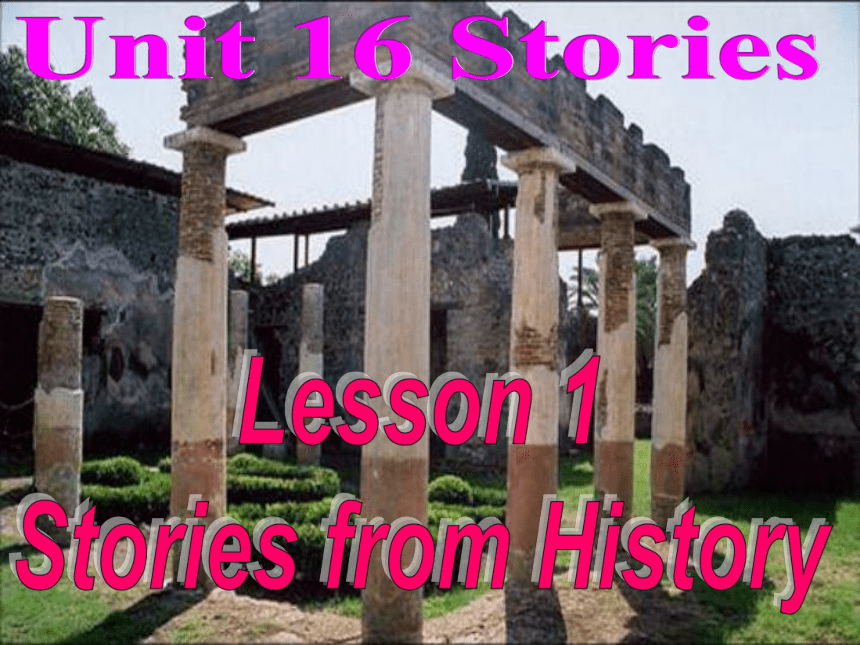 | |
| 格式 | zip | ||
| 文件大小 | 3.6MB | ||
| 资源类型 | 教案 | ||
| 版本资源 | 北师大版 | ||
| 科目 | 英语 | ||
| 更新时间 | 2016-04-16 20:17:24 | ||
图片预览

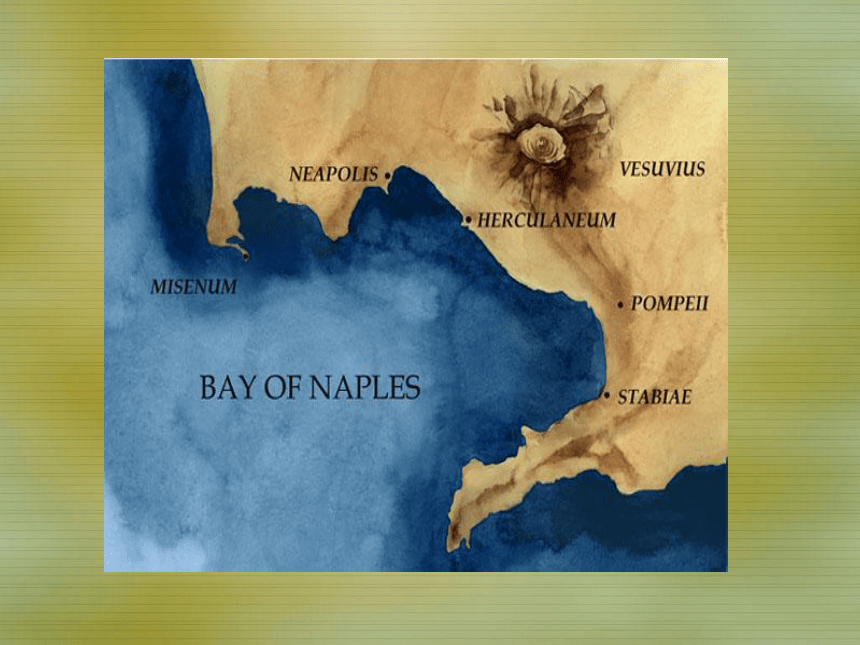
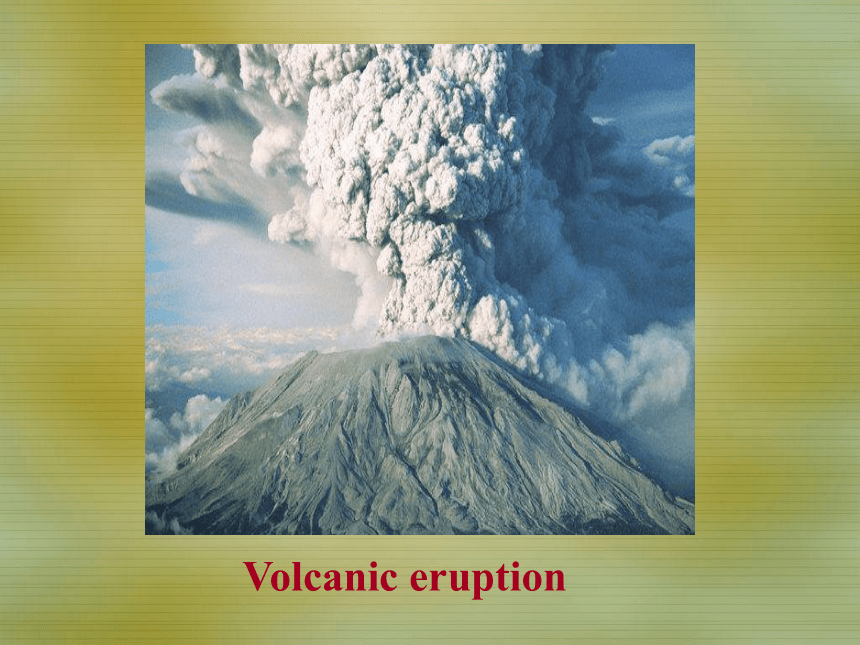
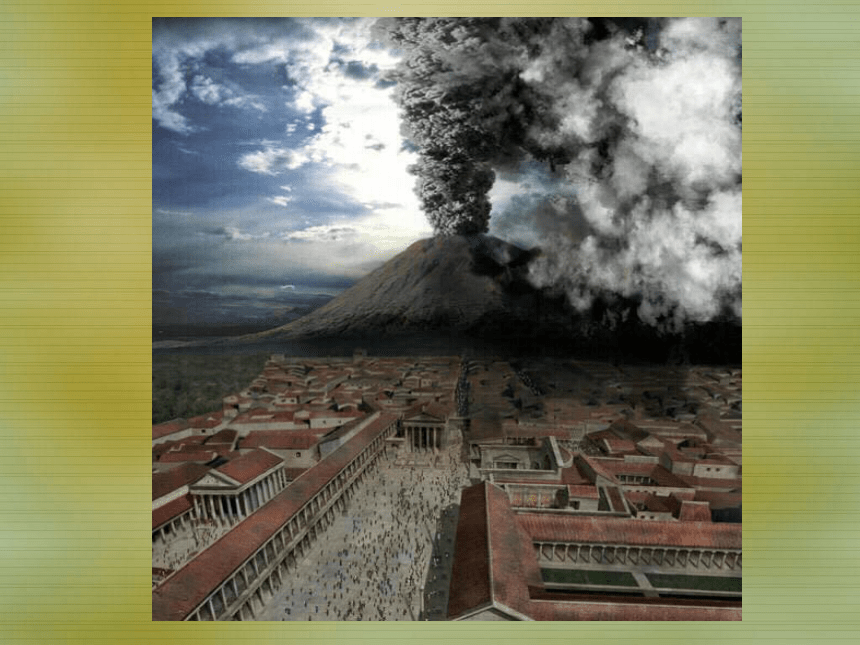
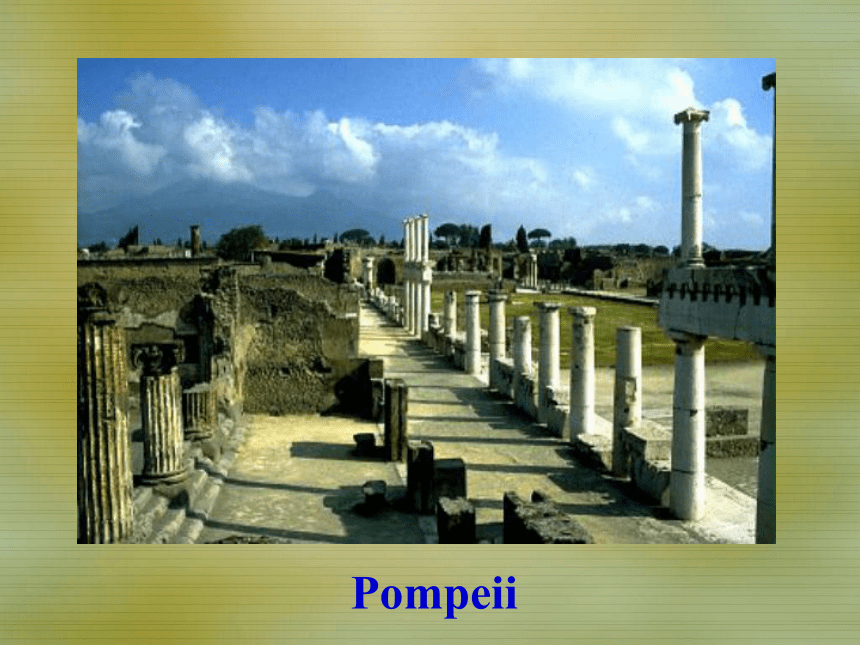

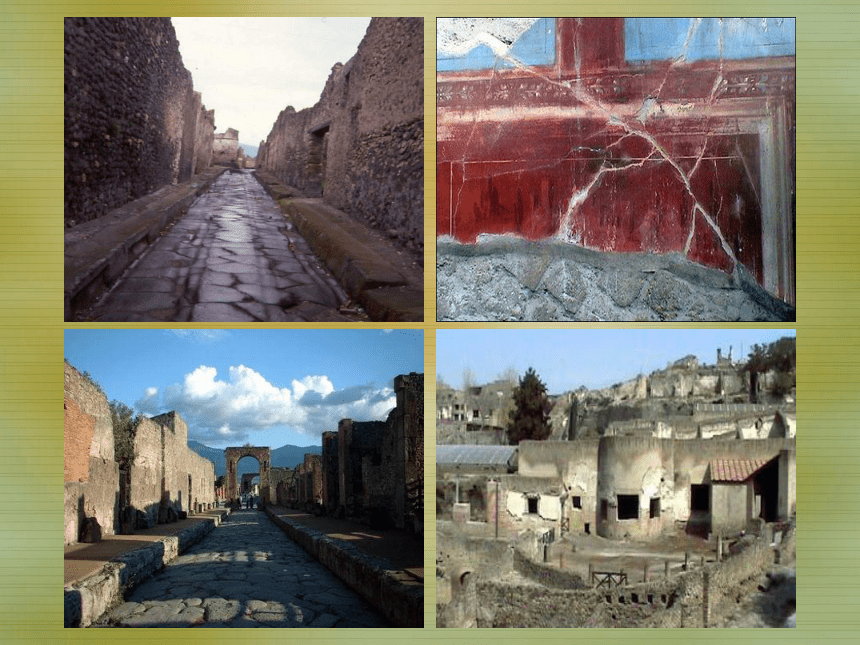
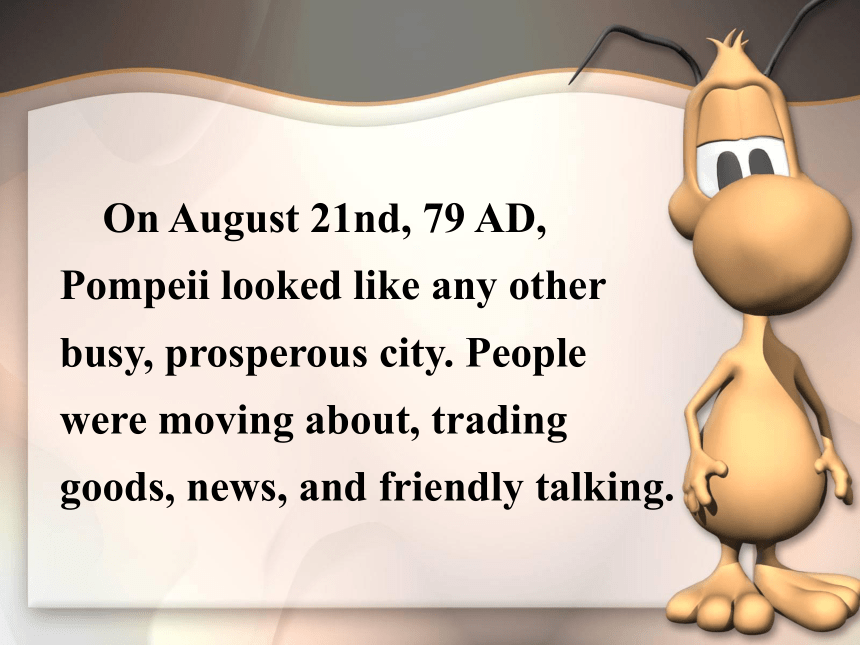
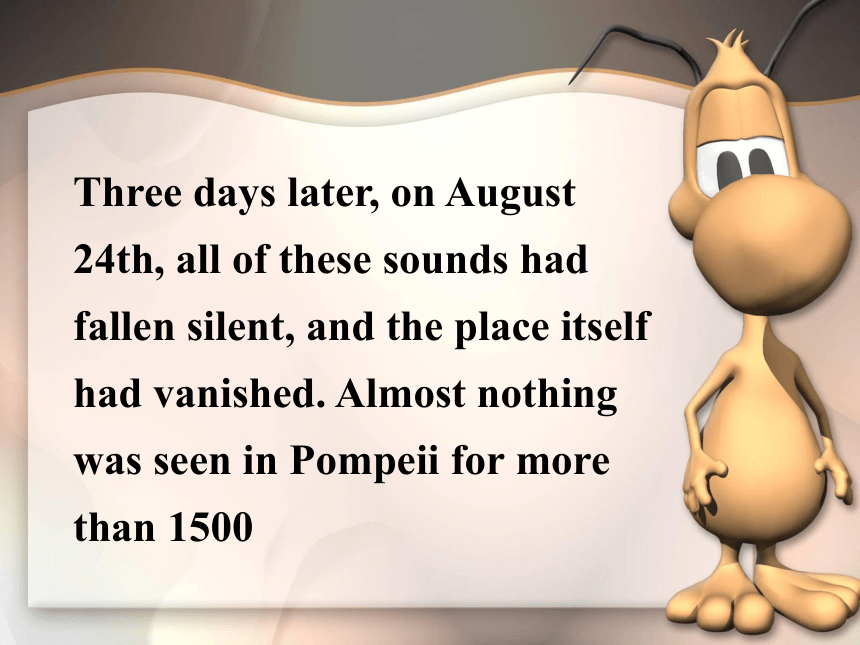
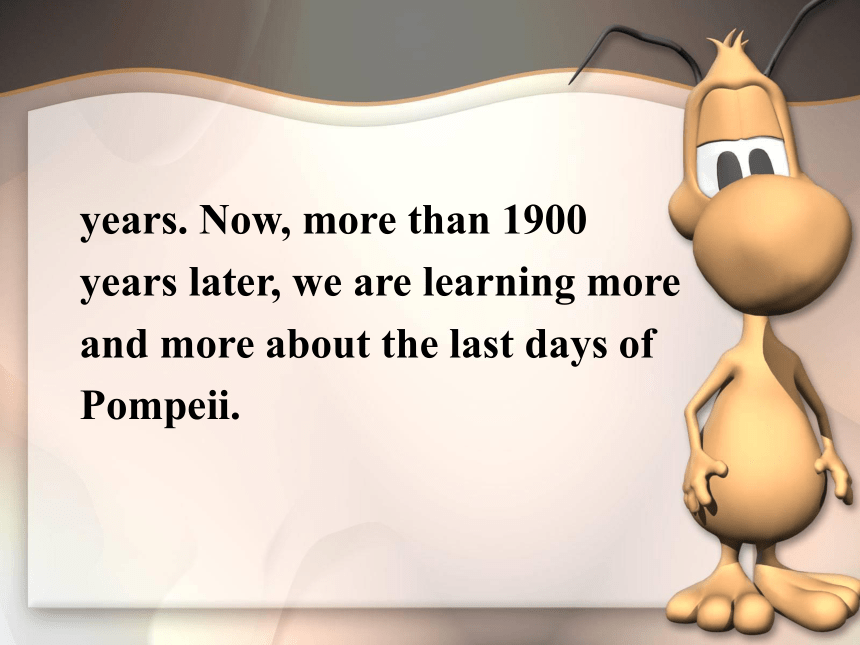


文档简介
课件52张PPT。Unit 16 StoriesLesson 1
Stories from HistoryVolcanic eruptionPompeii1. Once, there was a thriving city. But one day, it suddenly disappeared. Use your imagination, and see how this tragedy happened.Discussion2. Do you know any city that disappeared within a minute?3. Read the title, can you guess from the title what the article is about?First-reading
Read the whole passage quickly, and try to find out what happened to Pompeii.
It was destroyed and covered by a volcanic eruption and discovered again by some archaeologists 1,600 years later.Second-reading
Write down the things in connection with the following numbers.
August, 24th, 79 AD:
The eruption had occurred and destroyed the whole city. 1,600:
More than 1,600 years later, some scientists found the lost towns that had been buried under the ashes. 1748:
By 1748, scientists had found an awesome historical site. 250:
More than 250 years after scientists found the city, thousands of tourists and hundreds of scientists visit Pompeii every year to learn more about the ancient world.Go through the whole passage, and find out what the following people did.
Pliny:
People in Pompeii:
scientists:Third-reading: Note-takinga Roman writer
wrote about a terrible volcanic
eruption
described a cloud coming down the mountain, blocking out the sun and burying everything in its path, including whole villages and towns.Pliny:Those sad events left a deep impression on Pliny.People in Pompeii:disappeared under the ashes
were gradually forgotten by the worldPeople gathered together for protection in their last hours of life.One person, sitting alone, looks like he is praying.Another man, lying on his side, looks as if he is trying to get up.found the lost towns
found an awesome historical site and started to dig out the ancient city of Pompeii
hundreds of scientists visit Pompeii every year to learn more about the ancient worldThose scientists:Answer the questions in exercise 2.1. What is the article about?
It is about a city called Pompeii. It was buried by a volcanic eruption in 79 AD but scientists found it again 1,600 years later. Post-reading2. Why does the article describe Pompeii as a “time capsule”?
Because the volcanic eruption preserved buildings, objects and even impressions of people from the time.
3. Who wrote about the eruption of Vesuvius?
A Roman writer called Pliny. 4. What had Pompeii been like before the eruption?
Before the eruption, Pompeii had been a booming Roman city with temples, markets, restaurants, and theatres.5. What can you see if you walk in the streets of Pompeii today?
Now as you walk along the streets of the city, you can admire the ancient architecture, statues, decorated walls and authentic objects characteristic of the time.1. He had witnessed as a young man …
v. see something by oneself
2. The eruption had occurred on August 24th, 79AD.
take place, happen (vi.) Paraphrase3. The earth began to tremble and a volcano …
shake
4. He described a cloud coming down the mountain, blocking out the sun and burying everything in its path. hide the sun from being seen/ bury everything when it was passing
5. Time rewinds.
v. go back to ancient times6. You can admire the ancient architecture, statues, decorated walls and authentic objects
characteristics of the time.
typical of that time
7. One person, sitting alone, looks like he is praying. alone is an adverb(副词)
8. The city lives on nearly 2,000 years after its loss.
keep alive a container used to store for children a selection of objects thought to be representative of life at a particular time.
Time capsules are interesting to people of all ages. 9. Time capsuleWrite to yourself an e-mail, and receive it 20 years later. What will the feeling be?
The Forbes provides an interesting service, kinda TIME CAPSULE. But the ‘capsule’ would be an e-mail. you may send emails to yourself,
and decide the mails to be
received 1 or 3 or 5 or 10 or even
20 years later! The mails will
be kept and sent by yahoo.Changes of Pompeii City:
A thriving Roman city with
temples, markets, restaurants and
theatres, works of art on walls;destroyed and covered by a terrible
volcanic eruption; people
disappeared and forgotten by the
world; the locations of the buried
towns and villages were lost.discovered by some scientists;
visited by tourists and scientists
every year.Past Perfect tense1. Pliny wrote about a terrible volcanic eruption that he had witnessed as a young man.2. However, more than 1, 600 years later, some scientists found the lost towns that had been buried under the ashes.
3. Before the eruption occurred, it had been a booming Roman city.4. The bodies of people who had died in Pompeii left impressions in the ash ...It shows an event that happened
earlier, before the other past
event in the story.What is past perfect tense?Past Perfect 过去完成时had + past participle(动词的过去分词)规则动词不规则动词助动词(无人称变化)regular verbsirregular verbs过去分词的构成:1. 规则动词的变化:a) 一般情况下在动词后面加 ed work ------ worked play -------- playedb) 以 e 结尾的动词直接加 d use ------ used refuse ------ refusedc) 以辅音字母加 y 结尾的动词,把 y 改 i 再加 edstudy ----- studiedcarry ----- carriedd) 以重读闭音节结尾的,前面有单个元音字母时,双写辅音字母,再加 edstop ---- stoppeddrop ------- dropped2. 不规则动词的变化lightlighted/litholdheldbuy boughteateatenlose lostChina ________ the 29th Olympic Games. (hold) had heldHong Kong ____________ to China before Macao came back to China. (return)had returnedHenry, from London, married
Anna from Poland.
He once told a reporter that he
had never been in love until he
met Anna.Oral Exercise Suppose you were Henry, what else would you like to say to the reporter?
Visit Poland … fall in love with a
girl … eat Polish food … want
children … spend all his time on
one person … talk so openly …Thank you!
Stories from HistoryVolcanic eruptionPompeii1. Once, there was a thriving city. But one day, it suddenly disappeared. Use your imagination, and see how this tragedy happened.Discussion2. Do you know any city that disappeared within a minute?3. Read the title, can you guess from the title what the article is about?First-reading
Read the whole passage quickly, and try to find out what happened to Pompeii.
It was destroyed and covered by a volcanic eruption and discovered again by some archaeologists 1,600 years later.Second-reading
Write down the things in connection with the following numbers.
August, 24th, 79 AD:
The eruption had occurred and destroyed the whole city. 1,600:
More than 1,600 years later, some scientists found the lost towns that had been buried under the ashes. 1748:
By 1748, scientists had found an awesome historical site. 250:
More than 250 years after scientists found the city, thousands of tourists and hundreds of scientists visit Pompeii every year to learn more about the ancient world.Go through the whole passage, and find out what the following people did.
Pliny:
People in Pompeii:
scientists:Third-reading: Note-takinga Roman writer
wrote about a terrible volcanic
eruption
described a cloud coming down the mountain, blocking out the sun and burying everything in its path, including whole villages and towns.Pliny:Those sad events left a deep impression on Pliny.People in Pompeii:disappeared under the ashes
were gradually forgotten by the worldPeople gathered together for protection in their last hours of life.One person, sitting alone, looks like he is praying.Another man, lying on his side, looks as if he is trying to get up.found the lost towns
found an awesome historical site and started to dig out the ancient city of Pompeii
hundreds of scientists visit Pompeii every year to learn more about the ancient worldThose scientists:Answer the questions in exercise 2.1. What is the article about?
It is about a city called Pompeii. It was buried by a volcanic eruption in 79 AD but scientists found it again 1,600 years later. Post-reading2. Why does the article describe Pompeii as a “time capsule”?
Because the volcanic eruption preserved buildings, objects and even impressions of people from the time.
3. Who wrote about the eruption of Vesuvius?
A Roman writer called Pliny. 4. What had Pompeii been like before the eruption?
Before the eruption, Pompeii had been a booming Roman city with temples, markets, restaurants, and theatres.5. What can you see if you walk in the streets of Pompeii today?
Now as you walk along the streets of the city, you can admire the ancient architecture, statues, decorated walls and authentic objects characteristic of the time.1. He had witnessed as a young man …
v. see something by oneself
2. The eruption had occurred on August 24th, 79AD.
take place, happen (vi.) Paraphrase3. The earth began to tremble and a volcano …
shake
4. He described a cloud coming down the mountain, blocking out the sun and burying everything in its path. hide the sun from being seen/ bury everything when it was passing
5. Time rewinds.
v. go back to ancient times6. You can admire the ancient architecture, statues, decorated walls and authentic objects
characteristics of the time.
typical of that time
7. One person, sitting alone, looks like he is praying. alone is an adverb(副词)
8. The city lives on nearly 2,000 years after its loss.
keep alive a container used to store for children a selection of objects thought to be representative of life at a particular time.
Time capsules are interesting to people of all ages. 9. Time capsuleWrite to yourself an e-mail, and receive it 20 years later. What will the feeling be?
The Forbes provides an interesting service, kinda TIME CAPSULE. But the ‘capsule’ would be an e-mail. you may send emails to yourself,
and decide the mails to be
received 1 or 3 or 5 or 10 or even
20 years later! The mails will
be kept and sent by yahoo.Changes of Pompeii City:
A thriving Roman city with
temples, markets, restaurants and
theatres, works of art on walls;destroyed and covered by a terrible
volcanic eruption; people
disappeared and forgotten by the
world; the locations of the buried
towns and villages were lost.discovered by some scientists;
visited by tourists and scientists
every year.Past Perfect tense1. Pliny wrote about a terrible volcanic eruption that he had witnessed as a young man.2. However, more than 1, 600 years later, some scientists found the lost towns that had been buried under the ashes.
3. Before the eruption occurred, it had been a booming Roman city.4. The bodies of people who had died in Pompeii left impressions in the ash ...It shows an event that happened
earlier, before the other past
event in the story.What is past perfect tense?Past Perfect 过去完成时had + past participle(动词的过去分词)规则动词不规则动词助动词(无人称变化)regular verbsirregular verbs过去分词的构成:1. 规则动词的变化:a) 一般情况下在动词后面加 ed work ------ worked play -------- playedb) 以 e 结尾的动词直接加 d use ------ used refuse ------ refusedc) 以辅音字母加 y 结尾的动词,把 y 改 i 再加 edstudy ----- studiedcarry ----- carriedd) 以重读闭音节结尾的,前面有单个元音字母时,双写辅音字母,再加 edstop ---- stoppeddrop ------- dropped2. 不规则动词的变化lightlighted/litholdheldbuy boughteateatenlose lostChina ________ the 29th Olympic Games. (hold) had heldHong Kong ____________ to China before Macao came back to China. (return)had returnedHenry, from London, married
Anna from Poland.
He once told a reporter that he
had never been in love until he
met Anna.Oral Exercise Suppose you were Henry, what else would you like to say to the reporter?
Visit Poland … fall in love with a
girl … eat Polish food … want
children … spend all his time on
one person … talk so openly …Thank you!
